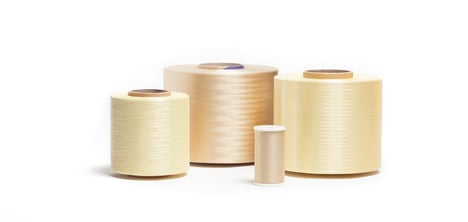 Modulus (fiber elasticity) is a key characteristic of industrial yarn and thread for wire and cable - specifically aramid yarns. Modulus refers to the ratio of stress (force per unit area) along an axis to strain (ratio of deformation over initial length) along that axis. Think about when you stretch a rubber band out to the point right before it deforms or breaks – that is the modulus. When something stretches to the point of deformation, the strength is almost always compromised.
Modulus (fiber elasticity) is a key characteristic of industrial yarn and thread for wire and cable - specifically aramid yarns. Modulus refers to the ratio of stress (force per unit area) along an axis to strain (ratio of deformation over initial length) along that axis. Think about when you stretch a rubber band out to the point right before it deforms or breaks – that is the modulus. When something stretches to the point of deformation, the strength is almost always compromised.
High modulus reinforcement elements (strength members) are used in wire and cable to minimize cable diameter and weight as well as increase resistance to deformation, allowing more force to be applied without damaging the material. Traditionally, aramid fibers (Kevlar® or Kevlar® alternatives) have been used because of their excellent combination of high modulus characteristics, low density and high electrical resistance. Strength and elasticity are especially critical when cable is run between power poles and exposed to various outdoor elements that put it under significant stress.
Here are a few important facts to consider:
- Polyester can be used as a strength member yarn, but it takes a lot more polyester to do what an aramid yarn can do in regard to strength, elasticity and performance
- Pound for pound, aramid yarns are five times stronger than steel
- When you need a lot of strength but not a lot of bulk, high modulus aramid yarns are a great solution for wire and cable applications that also require substantial elongation capacity
- Cable design largely drives strength member material. If you are manufacturing bulky cable, high modulus, low shrinkage (HMLS polyester) may be an appropriate choice. If you are manufacturing slender, lightweight cable used for aerial use, a high modulus aramid is a better choice
- Sustained stability over a wide range of temperatures and friction levels is another important factor in deciding what high modulus strength member yarn is the best fit for your wire and cable design
- Tensile testing can help examine material and determine the target modulus needed
High modulus yarn is used as a strength member in the manufacturing of wire and cable because of the important role it plays in tensile force. When wire and cable is pulled, stretched or put under any amount of stress, the force should be absorbed by the strength member yarn or reinforcement yarn, rather than the fiber optics.
Below is a comparison of two similarly sized aramids, one standard tenacity and one high modulus. The high modulus aramid requires significantly more initial force to stretch the material.
| Aramid Size & Type |
Breaking Strength (lbs) | Breaking Tenacity (g/dn) | Elongation @ Break (%) | LASE @ 0.5% (lbs) | LASE @ 1.0% (lbs) | Youngs Modulus (g/dn) |
| 1420dn High Modulus | 72.5 | 23 | 2.5 | 16.5 | 30.86 | 960 |
| 1500dn Standard Tenacity | 76.7 | 23 | 3.3 | 11.6 | 23 | 740 |
If you’re a manufacturer of wire and cable, you understand some of the challenges of processing textiles into various cable designs. Download our ebook Process Engineering Guide for Textiles in Wire & Cable, below to learn more about best practices and the latest processing tools available to help control yarn tension and other variables.



